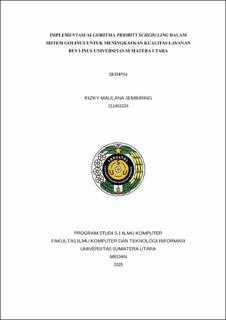| dc.description.abstract | This study aims to implement the Priority Scheduling algorithm in the Linus Bus transportation system of the University of North Sumatra to improve the efficiency of waiting time and bus fleet management. The research method used consists of four stages, namely the first problem identification, the second system design, the third implementation, and the fourth testing, which began with the distribution of questionnaires to 75 students. The results of the questionnaire showed that 92.5% of respondents complained about the uncertainty of waiting time, 96% wanted a clearer bus arrival estimate, and 96.1% needed real-time bus position information. Based on these results, the GoLinus system was designed using the Priority Scheduling algorithm to optimize passenger queues based on waiting time, and implemented in the form of a web-based application that allows users to monitor bus positions and arrival estimates in real-time. Simulation testing of the algorithm showed that the system successfully prioritized passengers who had been waiting longer, reduced waiting time, and increased operational efficiency. Evaluation of user satisfaction through a questionnaire showed that 87% of respondents were very satisfied, especially regarding the transparency of bus position information and arrival estimates. In addition, interviews with bus fleet managers revealed that previously manually managed systems can now be run more efficiently through system integration, which also helps manage the bus fleet in real-time and provides clear information to passengers, increasing convenience and operational efficiency. | en_US |


